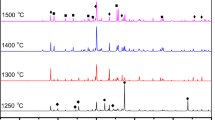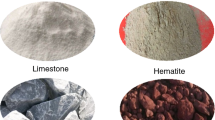Abstract
Phosphoaluminate cement clinker (PAC) was one type of cementitious material due to its high durability and mechanical performance. As the predominant mineral phase in PAC, the high-temperature formation and property of calcium phosphoaluminate mineral (C8A6P) were related closely with hydration and mechanical characteristic for PAC. Thus, the influence of BaO on the performance of C8A6P mineral phase was investigated carefully in this paper. It was found that BaO of 17.5–20% content could endow C8A6P mineral with predominant mechanical performance. This was due to the fact that C8A6P mineral was activated by BaO. Excessive BaO would lead to the formation of new unexpected phase BaO·Al2O3. The limited solid solubility of BaO in C8A6P mineral was 20%. The addition of BaO changed the ratio of hydration products of C2(A,P)H8 and C(A,P)H10 for C8A6P mineral.







Similar content being viewed by others
References
Medeiros MHF, Gobbi A, Rãus GC, et al. Reinforced concrete in marine environment: effect of wetting and drying cycles, height and positioning in relation to the sea shore. Constr Build Mater. 2013;44(44):452–7.
Zhou Y, Li M, Sui L, et al. Effect of sulfate attack on the stress train relationship of FRP-confined concrete. Constr Build Mater. 2016;110:235–50.
Du J, Ye J, Li G. Inhibitory effects of chloride ions on concrete sulfate attack in the marine adsorption environment. Mar Georesour Geotechnol. 2017;35(3):5.
Otieno M, Beushausen H, Alexander M. Chloride-induced corrosion of steel in cracked concrete—Part I: experimental studies under accelerated and natural marine environments. Cem Concr Res. 2016;79:373–85.
De Weerdt K, Orsáková D, Müller ACA, et al. Towards the understanding of chloride profiles in marine exposed concrete, impact of leaching and moisture content. Constr Build Mater. 2016;120:418–31.
Hui LI, Xiao H, Guan X, et al. Chloride diffusion in concrete containing nano-TiO2 under coupled effect of scouring. Compos Part B-Eng. 2014;56:698–704.
Swamy RN, Suryavanshi AK, Tanikawa S. Protective ability of an acrylic based surface coating system against chloride and carbonation penetration into concrete. ACI Mater. 1998;95(12):101–12.
Moradllo MK, Shekarchi M, Hoseini M. Time-dependent performance of concrete surface coatings in tidal zone of marine environment. Constr Build Mater. 2012;30(5):198–205.
Almusallam AA, Khan FM, Dulaijan SU, Al-Amoudi OSB. Effectiveness of surface coatings in improving concrete durability. Cem Concr Compos. 2003;25(4):473–81.
Al-Zahrani MM, Al-Dulaijan SU, Ibrahim M, Saricimen H, Sharif FM. Effect of waterproofing coatings on steel reinforcement corrosion and physical properties of concrete. Cem Concr Compos. 2002;24(1):127–37.
Hou D, Lu Z, Li X, Ma H, Li Z. Reactive molecular dynamics and experimental study of graphene-cement composites: structure, dynamics and reinforcement mechanisms. Carbon. 2007;115:188–208.
Hou D, Yu J, Wang P. Molecular dynamics modeling of the structure, dynamics, energetics and mechanical properties of cement-polymer nanocomposite. Compos Part B Eng. 2019;162:433–44.
Long W, Han N, Li D, et al. Research on chloride penetration resistance of phosphoaluminate cement concrete. In 4th international conference on the durability of concrete structures, 24–26 July 2014, Purdue University, West Lafayette, In, USA.
Wei Wang, Zhaohua Yi, Shiqun Li, et al. Sulfate resistance of novel phosphoaluminate cement. Chin Ceram Soc. 2008;36(1):82–7.
Liu Zhangsheng Hu, Jiashan Li Shiqun, et al. Study on the freezing resistance of phosphoaluminate cement. Chin Cement Eng. 2002;3:5–8.
Shiqun L, Jiashan H, et al. Fundamental study on aluminophosphate cement. Cem Concr Res. 1999;29(10):1549–54.
Jia L, Shiqun L, Jiashan H, et al. Study on the aluminophosphate glass-rich cement. Cem Concr Res. 2001;31(6):949–52.
Shiqun L, Guohui Z, Ning Z, et al. Study on hydraulic activity of aluminum-rich area in CaO–Al2O3–P2O5 system. Chin Ceram Soc. 1998;26(2):142–8.
Xing F, Zhang N, Ding Z, Liu B, Han NX, Wang WL, Li DW, Long WJ, Dong BQ, Wang XD. One type of ternary inorganic compound. China Patent, 201310733187.1. 2013-12-26.
Falzone G, Balonis M, Sant G. X-AFm stabilization as a mechanism of bypassing conversion phenomena in calcium aluminate cements. Cem Concr Res. 2015;72:54–68.
Wang Y, Li X, Zhu B, Chen P. Microstructure evolution during the heating process and its effect on the elastic properties of CAC-bonded alumina castables. Ceram Int. 2016;42(9):11355–62.
Shang X, Ye G, Zhang Y, Li H, et al. Effect of micro-sized alumina powder on the hydration products of calcium aluminate cement at 40 C. Ceram Int. 2016;42(13):14391–4.
Li S, Yi Z, Wang W, et al. Fundamental study on chemical stability of phosphoaluminate cement hardened pastes. Mater Res Innov. 2007;11(2):78–82.
Jiashan H. Phosphorus-aluminate binding material system. C.N. patent 1498870A, issued May 26, 2004.
Ramachandran VS, Feldman RF. Hydration characteristics of monocalcium aluminate at a low water/solid ratio. Cem Concr Res. 1973;3(6):729–50.
Heikal M, Morsy MS, Radwan MM. Electrical conductivity and phase composition of calcium aluminate cement containing air-cooled slag at 20, 40, and 60 C. Cem Concr Res. 2005;35(7):1438–46.
Acknowledgements
This work is supported by Natural Science Foundations of China (51672108), Natural NSFC-Shandong Joint Fund (No. U1806222), Key research and development plan of Shandong Province (2018GGX107009) and Horizontal scientific research of Shenzhen Gangchuang Building Materials Co., LTD (jk-807-2017). Also, supports from the 111 Project of International Corporation on Advanced Cement-based Materials (No. D17001) and the Taishan Scholars Program (No. ********) are greatly appreciated.
Author information
Authors and Affiliations
Corresponding authors
Additional information
Publisher's Note
Springer Nature remains neutral with regard to jurisdictional claims in published maps and institutional affiliations.
Rights and permissions
About this article
Cite this article
Wang, S., Liu, Y., Yang, S. et al. Effect of BaO on mechanical and hydration characteristic of C8A6P as predominant mineral in phosphoaluminate cement. J Therm Anal Calorim 139, 3499–3506 (2020). https://doi.org/10.1007/s10973-019-08723-6
Received:
Accepted:
Published:
Issue Date:
DOI: https://doi.org/10.1007/s10973-019-08723-6




